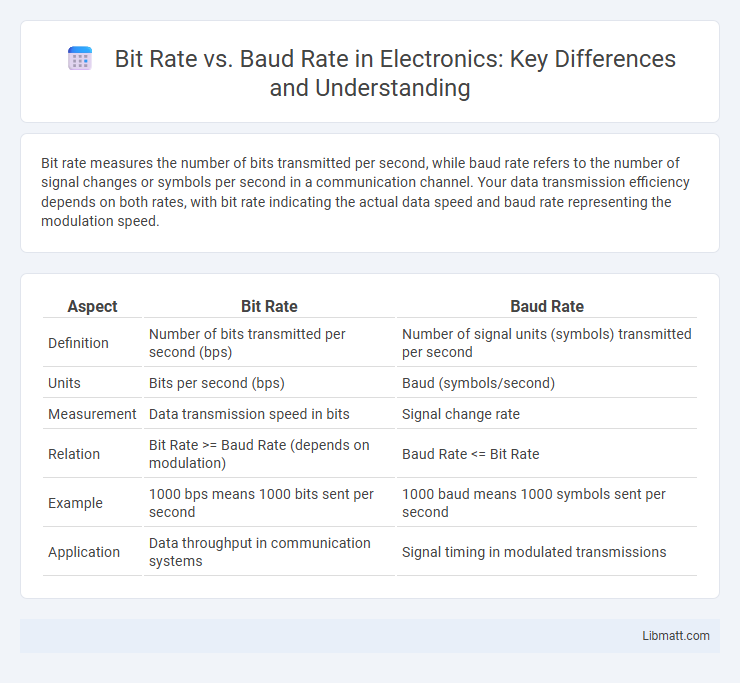Bit rate measures the number of bits transmitted per second, while baud rate refers to the number of signal changes or symbols per second in a communication channel. Your data transmission efficiency depends on both rates, with bit rate indicating the actual data speed and baud rate representing the modulation speed.
Table of Comparison
| Aspect | Bit Rate | Baud Rate |
|---|---|---|
| Definition | Number of bits transmitted per second (bps) | Number of signal units (symbols) transmitted per second |
| Units | Bits per second (bps) | Baud (symbols/second) |
| Measurement | Data transmission speed in bits | Signal change rate |
| Relation | Bit Rate >= Baud Rate (depends on modulation) | Baud Rate <= Bit Rate |
| Example | 1000 bps means 1000 bits sent per second | 1000 baud means 1000 symbols sent per second |
| Application | Data throughput in communication systems | Signal timing in modulated transmissions |
Introduction to Bit Rate and Baud Rate
Bit rate measures the number of bits transmitted per second in a digital communication system, reflecting data transfer speed. Baud rate indicates the number of signal changes or symbols sent per second, which can represent multiple bits depending on the modulation technique. Your understanding of these concepts is essential for optimizing network performance and selecting appropriate transmission methods.
Key Definitions: Bit Rate vs Baud Rate
Bit rate measures the number of bits transmitted per second in a communication channel, reflecting the data transfer speed. Baud rate represents the number of signal units or symbols sent per second, which may carry multiple bits per symbol depending on the modulation scheme. Understanding the distinction between bit rate and baud rate is crucial for optimizing Your data transmission efficiency and selecting appropriate communication protocols.
The Fundamental Differences Explained
Bit rate measures the number of bits transmitted per second, while baud rate indicates the number of signal units or symbols sent per second. Each symbol can represent multiple bits depending on the modulation scheme, making bit rate potentially higher than baud rate. Understanding the distinction is crucial for optimizing communication systems, especially in digital data transmission.
How Bit Rate and Baud Rate Affect Data Transmission
Bit rate refers to the number of bits transmitted per second, while baud rate measures the number of signal changes or symbols per second in a communication channel. Higher bit rates allow for faster data transfer, but if the modulation scheme carries multiple bits per symbol, the baud rate may be lower than the bit rate. Your data transmission speed depends on both rates, as optimizing modulation techniques can increase bit rate without increasing baud rate, improving bandwidth efficiency and overall communication performance.
Importance in Digital Communication Systems
Bit rate and baud rate are critical metrics in digital communication systems, defining the speed and efficiency of data transmission. Bit rate measures the number of bits transmitted per second, directly impacting data throughput and overall system performance. Baud rate indicates the number of signal units or symbols transmitted per second, which affects bandwidth utilization and error rates in communication channels.
Bit Rate vs Baud Rate: Calculation Methods
Bit rate measures the number of bits transmitted per second, calculated by multiplying the baud rate by the number of bits per symbol. Baud rate represents the number of signal units or symbols transmitted per second, determined directly from the symbol changes in the communication channel. Understanding the difference between these helps you optimize data transmission by selecting the appropriate modulation scheme to maximize bit rate efficiency.
Role in Modulation Techniques
Bit rate represents the number of bits transmitted per second, while baud rate measures the number of signal changes or symbols per second in a communication channel. In modulation techniques such as Quadrature Amplitude Modulation (QAM) and Phase Shift Keying (PSK), multiple bits are encoded into a single symbol, allowing the bit rate to exceed the baud rate. Efficient modulation schemes leverage this distinction to maximize data throughput without increasing the bandwidth or signal frequency.
Practical Applications and Use Cases
Bit rate measures the number of bits transmitted per second, crucial in digital communication systems such as Ethernet and Wi-Fi, where high data throughput is essential. Baud rate indicates the number of signal changes or symbols transmitted per second, playing a vital role in modems and serial communication protocols like RS-232. Understanding the distinction is key in optimizing performance for applications like streaming, data transfer, and telecommunication where bandwidth efficiency and error rates must be balanced.
Common Misconceptions and FAQs
Bit rate and baud rate are often confused; bit rate refers to the number of bits transmitted per second, while baud rate indicates the number of signal units sent per second. A common misconception is that both rates are always equal, but bit rate can be higher if multiple bits are encoded within a single signal change. Understanding this difference clarifies FAQs about communication speed, efficiency, and modulation techniques in digital transmission.
Summary: Choosing Between Bit Rate and Baud Rate
Bit rate measures the number of bits transmitted per second, while baud rate refers to the number of signal units or symbols sent per second in a communication channel. Selecting between bit rate and baud rate depends on the modulation technique; higher-order modulation allows multiple bits per symbol, making bit rate greater than baud rate. Optimizing data transmission requires understanding that bit rate defines effective data throughput, whereas baud rate relates to the signaling speed and bandwidth efficiency.
Bit Rate vs Baud Rate Infographic

 libmatt.com
libmatt.com